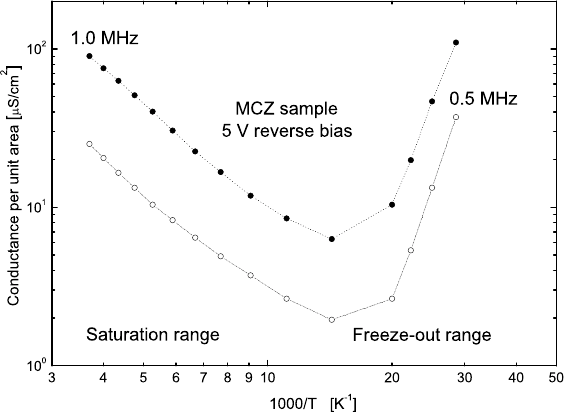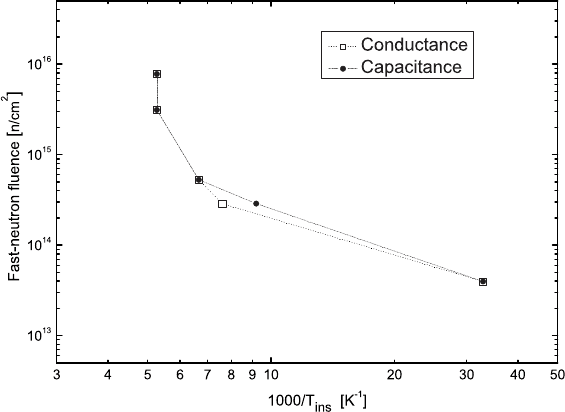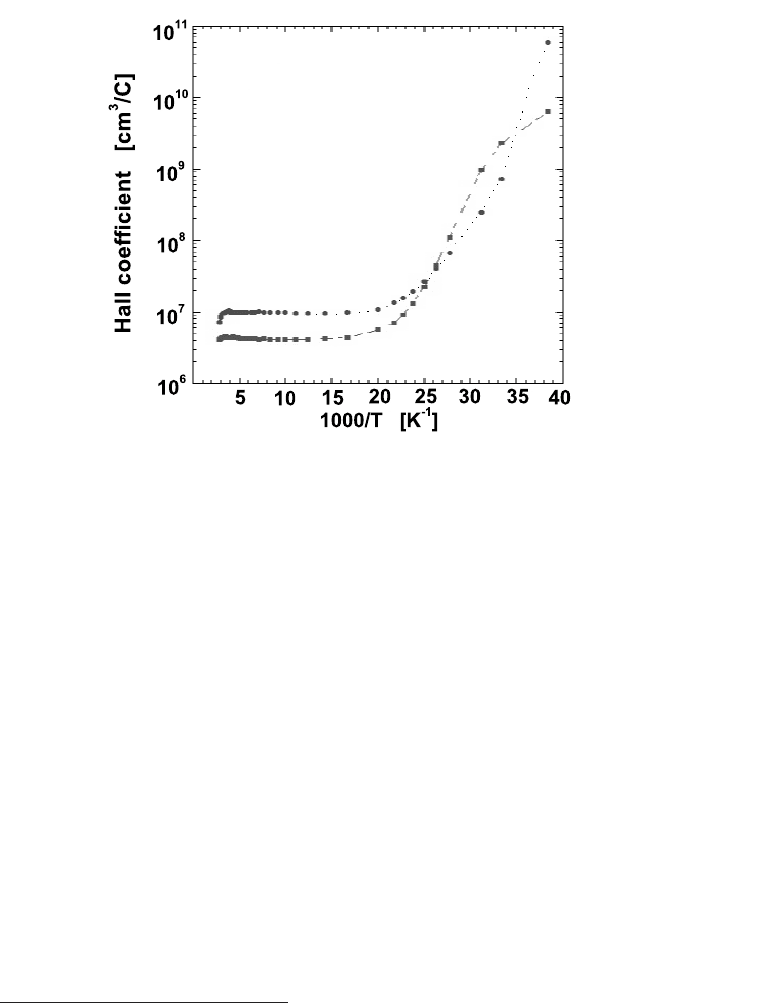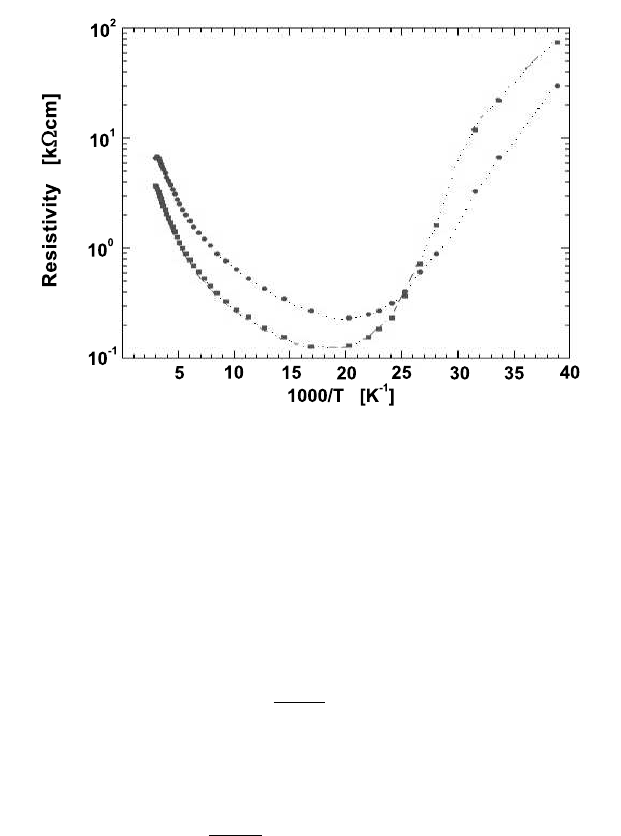Leroy C., Rancoita P.-G. Principles Of Radiation Interaction In Matter And Detection
Подождите немного. Документ загружается.


January 9, 2009 10:21 World Scientific Book - 9.75in x 6.5in ws-bo ok975x65˙n˙2nd˙Ed
400 Principles of Radiation Interaction in Matter and Detection
with the conductance (i.e., the real part of the admittance) given by
G(ω) =
R
d
+ R
b
+ ω
2
R
d
R
b
(R
d
C
2
d
+ R
b
C
2
b
)
(R
d
+ R
b
)
2
+ ω
2
R
2
d
R
2
b
(C
b
+ C
d
)
2
(4.153)
and the susceptance (i.e., the imaginary part of the admittance) given by
B(ω) = ω
·
ω
2
R
2
d
R
2
b
C
d
C
b
(C
b
+ C
d
) + R
2
d
C
d
+ R
2
b
C
b
(R
d
+ R
b
)
2
+ ω
2
R
2
d
R
2
b
(C
b
+ C
d
)
2
¸
. (4.154)
As well known, the conductance is the reciprocal of the equivalent circuit resistance,
thus
R
r,eff
(ω) =
(R
d
+ R
b
)
2
+ ω
2
R
2
d
R
2
b
(C
b
+ C
d
)
2
R
d
+ R
b
+ ω
2
R
d
R
b
(R
d
C
2
d
+ R
b
C
2
b
)
; (4.155)
while the susceptance expresses the capacitance,
C
r,eff
(ω) =
ω
2
R
2
d
R
2
b
C
d
C
b
(C
b
+ C
d
) + R
2
d
C
d
+ R
2
b
C
b
(R
d
+ R
b
)
2
+ ω
2
R
2
d
R
2
b
(C
b
+ C
d
)
2
, (4.156)
of the equivalent circuit multiplied by ω.
At ro om temperature, for non-irradiated and weakly doped (e.g., see Sect. 4.3.2)
devices
∗
, the reverse current is about or lower than 10 nA at full depletion voltage
and, as a consequence, R
d
is typically larger than about 10
4
MΩ, while C
d
is not
lower than 1 pF. Thus, even for fully depleted devices, i.e., when C
d
is at the mi-
nimum, we have that R
d
À 1/(ωC
d
) at frequencies above a few kHz. In addition,
since the time constant of the electrical neutral bulk
†
is the same as the dielectric
relaxation time τ
rel
(e.g., see Sections 7.6 and 7.7 of [Reitz and Milford (1970)] and
Section 6.3.4 of [Neamen (2002)])
τ
rel
= R
b
C
b
(4.157)
= ε ρ
bulk
(4.158)
≈ (3.2–7.4) × 10
−9
s,
we have that R
b
¿ 1/(ωC
b
) for frequencies . 10 MHz. When R
b
¿ 1/(ωC
b
) and
R
d
À 1/(ωC
d
), the equivalent circuit for the SIJD model can be approximated by
that shown in Fig. 4.29(b) and its admittance becomes:
Y
rT
(ω) =
ω
2
R
b
C
2
d
1 + ω
2
R
2
b
C
2
d
+ j ω
·
C
d
1 + ω
2
R
2
b
C
2
d
¸
. (4.159)
With decreasing temperature, the leakage current decreases and the condition
R
d
À 1/(ωC
d
) is satisfied at frequencies lower than a few kHz. Therefore, the equi-
valent circuit at low and very low temperatures, i.e., when the carriers start to freeze-
out (see Sect. 4.3.3.3), can be approximated with that shown in Fig. 4.29(c), whose
∗
Typically this type of device is similar to that described at page 397.
†
ρ
bulk
is the bulk resistivity [typically (3–7) kΩcm] of the device and ε is the silicon electric
permittivity (e.g., see Appendix A.2).

January 9, 2009 10:21 World Scientific Book - 9.75in x 6.5in ws-bo ok975x65˙n˙2nd˙Ed
Radiation Environments and Damage in Silicon Semiconductors 401
admittance is given by (e.g., see [Viswanathan, Divakaruni and Kizziar (1991); Di-
vakaruni, Prabhakar and Viswanathan (1994); Croitoru, David, Rancoita, Rattaggi
and Seidman (1997a, 1998b)]):
Y
lT
(ω) =
ω
2
R
b
C
2
d
1 + ω
2
R
2
b
(C
b
+ C
d
)
2
+ j ω C
d
·
1 + ω
2
R
2
b
C
b
(C
b
+ C
d
)
1 + ω
2
R
2
b
(C
b
+ C
d
)
2
¸
. (4.160)
In the temperature range (indicated as saturation range in Fig. 4.30) within
which the carrier concentration is almost constant, we can rewrite the conductance
term of Eq. (4.160) as (e.g., see [Croitoru, David, Rancoita, Rattaggi and Seid-
man (1997a)] and also [Viswanathan, Divakaruni and Kizziar (1991); Divakaruni,
Prabhakar and Viswanathan (1994); Li (1994a)]):
G
lT
(ω) = A
d
·
ω
2
ε
2
ρ
bulk
(d − X)
X
2
+ ω
2
ε
2
ρ
2
bulk
d
2
¸
, (4.161)
where A
d
is the device active area, ε is the silicon electric permittivity (e.g., see
Appendix A.2), X is the depth of the depletion region [e.g., Eq. (6.17)], d is the
thickness of the substrate, and ρ
bulk
is the resistivity
‡
of the extrinsic n-type sili-
con. It has to be noted that the resistivity depends on the temperature, because
the mobility varies (i.e., it increases with decreasing temperature) by almost two
orders of magnitude compared to that at 300 K (e.g., [Jonscher (1961); Misiakos and
Tsamakis (1994)]). In Eq. (4.161), for a test frequency of 1 MHz the term ω ε ρ
bulk
d
is smaller than X even in a partially depleted device. Thus, to a first approximation,
the conductance G
lT
is proportional to the resistivity and then has a similar tem-
perature dependence, i.e., that of 1/µ
n
(T ). For instance, the measured values of the
conductance (Fig. 4.30) for an MCZ-device operated at 5 V of reverse bias indicate
that
G
lT
(T ) ∝
1
T
−α
,
where α ' 2.3 for 170 . T . 270 K and α ' 1.8 for 70 . T . 150 K [Croitoru,
David, Rancoita, Rattaggi and Seidman (1997a,b); David (1997); Croitoru, David,
Rancoita, Rattaggi and Seidman (1998b)], in agreement with that expected due
to the temperature dependence of the electron mobility found in weakly doped
silicon ([Arora, Hauser and Roulston (1982); Misiakos and Tsamakis (1994)], see
also page 409 and Section 1.2 of [M¨uller and Kamins (1977)]).
When the carriers freeze-out, the resistivity increases again because the sili-
con substrate starts to become similar to an insulator. Furthermore, the function
G
lT
(ω, T )/ω has a maximum for
ω
p
(T ) =
1
ερ
bulk
(T )
X(T )
d
. (4.162)
In the freeze-out range of temperature, the free-carrier concentration depends on
both the compensation level and the energy level of the dopant atoms. Thus, it
‡
The resistivity is expressed as ρ
bulk
' 1/(e µ
n
n
0
), where µ
n
and n
0
are the mobility and the
concentration of electrons, respectively.

January 9, 2009 10:21 World Scientific Book - 9.75in x 6.5in ws-bo ok975x65˙n˙2nd˙Ed
402 Principles of Radiation Interaction in Matter and Detection
is possible to determine the energy level of the dopant atoms by means of the
measurement of ω
p
(T ) as a function of T ([Viswanathan, Divakaruni and Kizziar
(1991); Divakaruni, Prabhakar and Viswanathan (1994)] and references therein). It
has to be added that the depth of the depleted layer (X) may depend on the
temperature because i) fewer ionized dopants are available to create the space-charge
region and ii) the carrier concentrations in the p
+
- and n-region exhibit different
freeze-out ranges of temperature due to the large difference between their dopant
concentrations [see Sect. 4.3.3.3 and references therein]. Furthermore, the resistance
of the bulk silicon increases with decreasing temperature so that ωR
b
(C
b
+C
d
) À 1
at low frequency. Therefore as experimentally observed
§
(e.g., page 397, see also [Li,
Chen and Kraner (1991); Divakaruni, Prabhakar and Viswanathan (1994); Croitoru,
David, Rancoita, Rattaggi and Seidman (1997a); Croitoru, Rancoita, Rattaggi,
Rossi and Seidman (1997)] and references therein), from Eq. (4.160) the capacitance
of the equivalent circuit becomes independent of frequency and approaches
C
r,eff
(ω) '
C
b
C
d
C
b
+ C
d
= C
geo
,
where
C
geo
=
εA
d
d
is the total capacitance of the medium, for R
b
so large that it can be ignored in the
equivalent circuit shown in Fig. 4.29(c).
The reverse-biased capacitance (C
d
) of a p
+
−n junction depends on the deple-
tion depth X [see Eq. (6.35) and discussion in Sect. 6.1.3] which, in turn, depends
[Eq. (6.17)] on the applied reverse bias (V
r
) and on the donor (i.e., a shallow impu-
rity) concentration (N
d
), thus, by combining Eqs. (6.17, 6.35) we obtain:
C
d
= A
d
s
eεN
d
2(V
0
+ V
r
)
, (4.163)
where V
0
is the built-in voltage [Eq. (6.12)]. In the substrate, the presence of trap-
ping or deep centers results in a frequency dependence of the capacitance related
to the energy levels of the centers because, at the edge of the depletion region,
the ionization state of these centers may become unable to follow the variation of
the applied voltage over the full spectrum of frequencies. For instance in the Sah-
Reddi model [Sah and Reddi (1964)], if a junction contains deep impurities, the
reverse-biased capacitance (C
d,t
) can be written as
C
d,t
= C
d
½
1 −
φ
t
V
0
+ V
r
·
N
t
(ω)
N
d
¸¾
−
1
2
, (4.164)
where C
d
is given by Eq. (4.163), N
t
(ω) is the frequency-dependent concentra-
tion of deep impurities, φ
t
is the energy difference b etween the Fermi level (of
§
At 18 K in the devices mentioned at page 397, the capacitance is independent of the applied
reverse bias at a frequency of 300 Hz.

January 9, 2009 10:21 World Scientific Book - 9.75in x 6.5in ws-bo ok975x65˙n˙2nd˙Ed
Radiation Environments and Damage in Silicon Semiconductors 403
Fig. 4.30 Conductance per unit of active area measured at 1 and 0.5 MHz as a function of the
temperature (in 1000/T with T in Kelvin) for a non-irradiated sample with n-type MCZ substrate
and operated at a reverse bias of 5 V (adapted from [Leroy and Rancoita (2007)]). The lines
are to guide the eye. Within the saturation range of temperature the concentration of carriers is
almost constant (i.e., almost all the dopant atoms are ionized), but depends on the temperature in
the freeze-out range (see also [Croitoru, David, Rancoita, Rattaggi and Seidman (1997a, 1998b)]
and [David (1997)]).
the silicon substrate) and the level of the deep center divided by the electronic
charge e. This model has been extended to treat more than one deep center for
non-irradiated (e.g., see [Beguwala and Crowell (1974)] and references therein) and
irradiated (e.g., see [Li (1994a)] and references therein) devices. Investigations of
the frequency and temperature-dependence of the junction capacitance allow the
determination of these deep center levels (e.g., see Section 8.3 of [Milnes (1973)],
also [Sah and Reddi (1964); Schultz (1971); Beguwala and Crowell (1974)] and refe-
rences therein). The mechanism of the repetitive filling and emptying of deep levels
in the depletion region of a junction is also utilized in the deep-level transient spec-
troscopy (DLTS, e.g., see Sect. 4.2.2) [Lang (1974)]. The DLTS exploits the thermal
discharging of the occupied traps which results from capacitance transients induced
by a pulsed bias.
Systematic investigations of the admittance dep endence on temperature were
carried out for fast-neutron fluences up to ≈ 10
16
n/cm
2
(e.g., [Li (1994a); Croitoru,
Gambirasio, Rancoita and Seidman (1996); Croitoru, Rancoita, Rattaggi, Rossi and
Seidman (1997); Croitoru, David, Rancoita, Rattaggi and Seidman (1998a)] and re-
ferences therein) and for temperatures down to 10 K (e.g., [Croitoru, Rancoita,
Rattaggi, Rossi and Seidman (1997); Croitoru, David, Rancoita, Rattaggi and Sei-

January 9, 2009 10:21 World Scientific Book - 9.75in x 6.5in ws-bo ok975x65˙n˙2nd˙Ed
404 Principles of Radiation Interaction in Matter and Detection
Fig. 4.31 Values of T
ins
(in K) when the conductance (2) and the capacitance (•) of the samples
irradiated with fast-neutron fluences up to ≈ 10
16
n/cm
2
become independent of the test frequency
(adapted from [Leroy and Rancoita (2007)]; see also [David (1997)]). The lines are to guide the
eye.
dman (1998a)] and references therein).
For fast-neutron fluences . 10
13
n/cm
2
, a quasi non-irradiated model by means
of Eq. (4.160) can approximately describe the equivalent circuit behavior of the ir-
radiated samples with decreasing temperature. For instance, the conductance exhi-
bits an approximate ω
2
dependence [e.g., see Eq. (4.161)], like the response of the
equivalent circuit of non-irradiated devices outside the freeze-out range of tempe-
rature [Croitoru, David, Rancoita, Rattaggi and Seidman (1998a)]. However, the
non-freeze-out range of temperature was found to depend on fluence [Croitoru,
David, Rancoita, Rattaggi and Seidman (1998a)]. Moreover, as for non-irradiated
devices (Fig. 4.30), the conductance reaches a minimum and then increases again
with decreasing temperature. For a fluence of ≈ 10
11
(10
13
) n/cm
2
the minimum
occurs at ≈ 70 (150) K [David (1997); Croitoru, David, Rancoita, Rattaggi and
Seidman (1998a)]. In addition, at room temperature [Li (1994a)], the capacitance
behavior of devices irradiated with fast-neutron fluences . 3.2 × 10
13
n/cm
2
is de-
scribed by Eq. (4.154). In this latter equation, the depletion region capacitance has
to account for the trapping centers generated by irradiation, but treated similarly
to deep defects [e.g., see Eq. (4.164)] in the framework of the Sah–Reddi model [Sah
and Reddi (1964)].
A progressive departure from the quasi non-irradiated model description ap-
pears for fluences above ≈ 4 × 10
13
n/cm
2
[Croitoru, David, Rancoita, Rattaggi

January 9, 2009 10:21 World Scientific Book - 9.75in x 6.5in ws-bo ok975x65˙n˙2nd˙Ed
Radiation Environments and Damage in Silicon Semiconductors 405
and Seidman (1998a)]. For instance, the dependence of the conductance on ω goes
as ω
m
with m < 2 [David (1997); Croitoru, David, Rancoita, Rattaggi and Sei-
dman (1998a)]. Furthermore (e.g., see Sect. 4.3.4) for f = 10 kHz [Croitoru, Ran-
coita, Rattaggi, Rossi and Seidman (1997)], the capacitance becomes independent
of the applied voltage at a temperature larger than the one corresponding to a non-
irradiated device (e.g., see page 397). More generally, it has been demonstrated that,
within the experimental errors [David (1997)], the conductance and the capacitance
of the irradiated devices become independent of the frequency
∗
and of the applied
reverse-bias at a temperature T
ins
(see Fig. 4.31), which increases with increasing
fluence (i.e., with the concentration of the created complex-defects, see Sect. 4.2.2,
which are electrically active): T
ins
is ≈ 190 K for a fluence of 7.8 × 10
15
n/cm
2
. A
general model, which has been proposed to account for the behavior of G(ω) and
C(ω) at these neutron fluences, assumes that i) the irradiation changes the value
of the resistivity in localized volumes inside the silicon and that ii) in these lat-
ter regions the medium can have a different frequency dependence with respect to
that in the undamaged regions (e.g., [Croitoru, David, Rancoita, Rattaggi and Sei-
dman (1998a)], see also [Croitoru, Dahan, Rancoita, Rattaggi, Rossi and Seidman
(1997)]).
4.3.5 Resistivity, Hall Coefficient and Hall Mobility at Large
Displacement Damage
In Sections 4.3.2–4.3.4 some of the main distinctive characteristics of non-irradiated
and irradiated silicon semiconductors were apparent from their simple transport
properties. Additional investigations were carried out to determine further proper-
ties: for example the Hall coefficient shows whether the charges are transported by
positive or negative carriers in extrinsic semiconductors. The Hall coefficient is of
primary importance since, except for a numerical factor (the so-called Hall factor
or scattering factor) of the order of unity, it is the reciprocal of the carrier density
and electronic charge
§
. Thus, it provides an immediate indication of the type and
concentration of dopants in the sample and can be combined with the conducti-
vity
¶
to determine the carrier mobility (the so-called Hall mobility). However, in
materials partly compensated by impurities of the opposite type, the simple mea-
surement of the Hall coefficient may not be easily interpreted to determine the type
of majority-carriers.
The Hall scattering factor is indicated as r
e
(r
h
) for electrons (holes) and ex-
presses the effect of the magneto-resistance: it accounts for the energy dependence
∗
The range of employed frequencies were 10 ≤ f ≤ 10
3
kHz.
§
For a general introduction to the Hall effect, the reader may see, for instance, [Putley (1960)],
Section 2 of [Blood and Orton (1978)], Chapter 5 of [Smith (1978)], Chapter 3 in [Blood and Orton
(1992)] and [Popovic (2004)]; for the Hall factor and its dependence on temperature, the reader
may read, for instance, [Norton, Braggins and Levinstein (1973); Kirnas, Kurilo, Litovchenko,
Lutsyak and Nitsovich (1974)] and Section 2.6.2 of [Blood and Orton (1978)].
¶
The conductivity is the reciprocal of the resistivity.

January 9, 2009 10:21 World Scientific Book - 9.75in x 6.5in ws-bo ok975x65˙n˙2nd˙Ed
406 Principles of Radiation Interaction in Matter and Detection
Fig. 4.32 Absolute value of the Hall coefficient, in cm
3
/C, as a function of the temperature, in
1000/T with T in K, for two non-irradiated n-type samples (from [Leroy and Rancoita (2007)]) with
resistivities of ≈ 2.7 (¥) and ≈ 6 (•) kΩcm at room temperature (see [Croitoru, Gubbini, Rancoita,
Rattaggi and Seidman (1999a,b)], respectively). The temperature range is 25 ≤ T ≤ 350 K. The
lines are to guide the eye.
of the relaxation time with respect to the carrier motion in presence of a magnetic
field (e.g., see Chapter 5 of [Smith (1978)]). The values of the relaxation time
k
for
electrons and holes are not necessarily the same and may depend on the tempera-
ture, the energy of the carrier and the shape of the constant-energy surfaces in the
k-vector
∗∗
space. Experimental determinations and theoretical predictions of the
Hall factor as a function of temperature and dopant concentration under the low
magnetic-field approximation
††
can be found, for instance, in [Messier and Merlo-
Flores (1963); Norton, Braggins and Levinstein (1973); Rode (1973); Dmitrenko et
al. (1974); Kirnas, Kurilo, Litovchenko, Lutsyak and Nitsovich (1974); Blood and
Orton (1978)]: at room temperature, in weakly doped silicon semiconductors, r
e
and
r
h
are ≈ 1.15 and 0.80, respectively (e.g., see Chapter 3 of [Blood and Orton (1992)],
[Mangiagalli, Levalois, Marie, Rancoita and Rattaggi (1999)] and, also, [Norton,
Braggins and Levinstein (1973); Rode (1973); Kirnas, Kurilo, Litovchenko, Lutsyak
and Nitsovich (1974)]).
For a partly compensated silicon semiconductor, under low magnetic-field appro-
k
The relaxation time expresses the mean free time between carrier collisions.
∗∗
The wave-vector, k, is the momentum of the particle divided by ~.
††
The low magnetic-field approximation (e.g., Section 2.2 of [Blood and Orton (1978)] and, also,
Section 5.3.4 of [Smith (1978)]) can be expressed by the condition µ
c
B ¿ 1 where µ
c
and B are
the carrier mobility and the magnetic-field, respectively.

January 9, 2009 10:21 World Scientific Book - 9.75in x 6.5in ws-bo ok975x65˙n˙2nd˙Ed
Radiation Environments and Damage in Silicon Semiconductors 407
ximation, the Hall coefficient is given by {see Equation (147) at page 128 of [Smith
(1978)]}:
R
H
= −
1
e
·
r
e
b
2
n − r
h
p
(b n + p )
2
¸
(4.165)
= −
1
e
·
r
e
µ
2
e
n − r
h
µ
2
h
p
(µ
e
n + µ
h
p)
2
¸
= eρ
2
µ
2
h
¡
r
h
p − r
e
b
2
n
¢
, (4.166)
where
b =
µ
e
µ
h
,
µ
e
(µ
h
) is the mobility
∗
, sometimes referred to as conductivity-mobility, of electrons
(holes); n (p) is the concentration
‡‡
of free electrons (holes) and, finally, the silicon
resistivity ρ is
ρ =
1
e(µ
e
n + µ
h
p)
(4.167)
=
1
eµ
h
(b n + p)
. (4.168)
For instance, at room temperature in an (almost) intrinsic and non-irradiated silicon
semiconductor b is ≈ 3 and the Hall coefficient [computed using Eq. (4.165)] is
negative, i.e., the current is mainly carried by electrons. For extrinsic silicon under
low magnetic-field, Eq. (4.165) can be rewritten as
R
H,e
= −
r
e
n e
for n À p (4.169)
and as
R
H,h
=
r
h
p e
for p À b n and p À b
2
n. (4.170)
The Hall coefficient can be experimentally determined by measuring the so-called
Hall voltage (due to the Hall effect), when a magnetic-field is applied to a semicon-
ductor carrying a current (e.g., see [Putley (1960); Popovic (2004)]).
The Hall mobility, µ
H
, is defined as the product of the Hall coefficient and the
conductivity ℘:
µ
H
= |R
H
|℘
=
|R
H
|
ρ
, (4.171)
where
ρ =
1
℘
∗
The dependence of the mobility on the temperature and concentration is discussed in Sect. 7.1.5
(see [Arora, Hauser and Roulston (1982)] and references therein).
‡‡
At thermal equilibrium we have np = n
2
int
(e.g., see Sect. 6.1).

January 9, 2009 10:21 World Scientific Book - 9.75in x 6.5in ws-bo ok975x65˙n˙2nd˙Ed
408 Principles of Radiation Interaction in Matter and Detection
Fig. 4.33 Resistivity, in kΩcm, as a function of the temperature, in 1000/T with T in K, for
two non-irradiated samples (from [Leroy and Rancoita (2007)]) with resistivities of ≈ 2.7 (¥) and
≈ 6 (•) kΩcm at room temperature (see [Croitoru, Gubbini, Rancoita, Rattaggi and Seidman
(1999a,b)], respectively). The temperature range is 25 ≤ T ≤ 350 K. The lines are to guide the
eye.
is the resistivity. It can be determined when combined measurements of the Hall
coefficient and resistivity (see later) are performed on the same sample. For an
extrinsic silicon semiconductor, under low magnetic-field, from Eqs. (4.169–4.171)
we have:
µ
H,e
=
|R
H,e
|
ρ
n
= r
e
µ
e
for n À p, (4.172)
in which ρ
n
is the resistivity of the n-type silicon and
µ
H,h
=
|R
H,h
|
ρ
p
= r
h
µ
h
for p À b n and p À b
2
n, (4.173)
where ρ
p
is the resistivity of the p-type silicon.
The temperature dependence of the Hall coefficient [Eq. (4.169)] of non-
irradiated n-type silicon samples with resistivities of ≈ 2.7 [Croitoru, Gubbini,
Rancoita, Rattaggi and Seidman (1999b)] and ≈ 6 kΩcm [Croitoru, Gubbini, Ran-
coita, Rattaggi and Seidman (1999a)] is shown in Fig. 4.32. Above room tempera-
ture (i.e., 1000/T . 3.33), the rapid decrease of the Hall coefficient with increasing
temperature results from the increase of the intrinsic carrier concentration [e.g., see
Eq. (4.146)]. R
H,e
is almost constant up to 1000/T ≈ 20 (18) for the sample with

January 9, 2009 10:21 World Scientific Book - 9.75in x 6.5in ws-bo ok975x65˙n˙2nd˙Ed
Radiation Environments and Damage in Silicon Semiconductors 409
resistivity of ≈ 6 kΩcm (≈ 2.7 kΩcm) resistivity (Fig. 4.32). Below these tempera-
tures, the carriers start to freeze-out (e.g., see Sect. 4.3.3.3) and the Hall coefficient
increases, as expected.
To make a Hall measurement, the sample is typically prepared in a bridge form
(e.g., see Section 5.2 of [Bar-Lev (1993)]) or in a rectangular bar with side arms
(e.g., see Section 2.3 of [Blo od and Orton (1978)]) or in an arbitrary form by means
of van der Paw’s method [van der Pauw (1958)]. Thus, the same sample may be
used for conductivity measurements. In Fig. 4.33, the resistivity dependence on
temperature is shown for non-irradiated samples
∗
with high- (≈ 6 kΩcm [Croitoru,
Gubbini, Rancoita, Rattaggi and Seidman (1999a)]) and low-resistivity (≈ 2.7 kΩcm
[Croitoru, Gubbini, Rancoita, Rattaggi and Seidman (1999b)]). The data exhibit
an overall agreement with the predicted resistivity-dependence on temperature, as
discussed in Sects. 4.3.3.3 and 4.3.4. For instance, using the data shown in Fig. 4.33
obtained for a sample with a resistivity of ≈ 6 kΩcm [Croitoru, Gubbini, Rancoita,
Rattaggi and Seidman (1999a)] in the temperature range 190 ≤ T ≤ 300 K, the
temperature dependence of the electron-mobility is given by:
µ
e
= µ
0,e
T
−α
[cm
2
V
−1
s
−1
], (4.174)
where µ
0,e
= (8.5 ± 0.2) ×10
8
, T is the temperature (in Kelvin) and the coefficient
α = 2.31±0.02 is in agreement with that determined by conductance measurements
(e.g., see page 401) and by other authors (e.g., see [Arora, Hauser and Roulston
(1982); Misiakos and Tsamakis (1994)]).
It has to be noted that the combined measurements of the Hall coefficient and re-
sistivity allow one to determine both the mobility and the free carrier concentration
in extrinsic semiconductors [e.g., see Eqs. (4.169, 4.170, 4.172, 4.173)].
Measurements of resistivity, Hall coefficient and Hall mobility were carried out
after irradiation
∗∗
with different types of particles up to large fluences and as a
function of temperature. At room temperature the resistivity of the irradiated sam-
ples of extrinsic (p- and n-type) silicon has been observed to increase with respect
to that before irradiation
§
and to become even larger than that of the intrinsic
silicon (e.g., see [Borchi and Bruzzi (1994); Li (1994b); Croitoru, Dahan, Rancoita,
Rattaggi, Rossi and Seidman (1997, 1998); Mangiagalli, Levalois, Marie, Rancoita
∗
For these samples, the dependence of Hall coefficients on temperature is that shown in Fig. 4.32.
∗∗
The reader can see, e.g., [Konozenko, Semenyuk and Khivrich (1969); Lugakov, Lukashevich
and Shusha (1982); Borchi and Bruzzi (1994); Li (1994b); Biggeri, Borchi, Bruzzi and Lazanu
(1995); Biggeri, Borchi, Bruzzi, Pirollo, Sciortino, Lazanu and Li (1995); Croitoru, Dahan, Ran-
coita, Rattaggi, Rossi and Seidman (1997, 1998); Mangiagalli, Levalois, Marie, Rancoita and
Rattaggi (1998); Croitoru, Gubbini, Rancoita, Rattaggi and Seidman (1999a,b); Mangiagalli, Lev-
alois, Marie, Rancoita and Rattaggi (1999); Pirollo et al. (1999); Consolandi, Pensotti, Rancoita
and Tacconi (2008)].
§
One can see, e.g., [Borchi and Bruzzi (1994); Li (1994b); Biggeri, Borchi, Bruzzi and Lazanu
(1995); Biggeri, Borchi, Bruzzi, Pirollo, Sciortino, Lazanu and Li (1995); Croitoru, Dahan, Ran-
coita, Rattaggi, Rossi and Seidman (1997, 1998); Mangiagalli, Levalois, Marie, Rancoita and
Rattaggi (1998); Croitoru, Gubbini, Rancoita, Rattaggi and Seidman (1999a,b); Mangiagalli, Lev-
alois, Marie, Rancoita and Rattaggi (1999); Pirollo et al. (1999)], Section 2 in Chapter II of Part II
of [Vavilov and Ukhin (1977)], Section 5.13 of [Messenger and Ash (1992)] and references therein.
